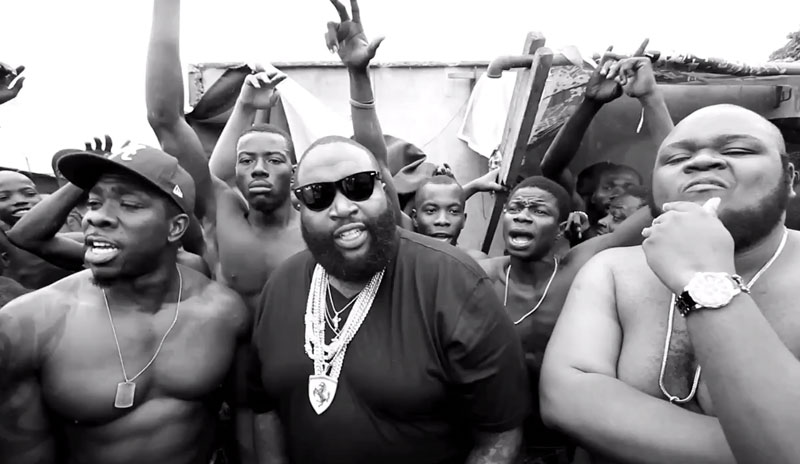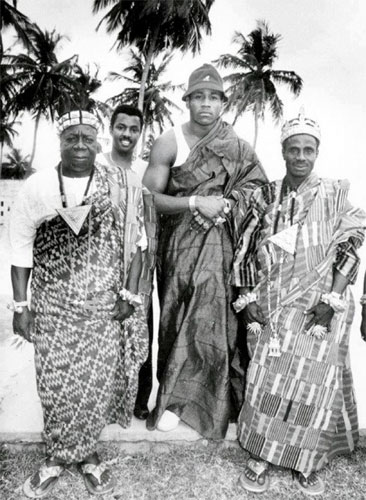
Rick Ross is not the first American hip hop artist to enjoy touring the African continent; ever since the late eighties when LL Cool J performed in Abidjan there’s been the occasional motherland trip for a major artist, and in recent years a steady stream of emcees, from the big names to the underground, have been setting foot in Africa. Where ‘Africa’ used to invoke fear of sickness, war and crime in the hearts of the aspiring traveling emcee, nowadays many artists have a more reassuring image of the continent. Also, there’s more cash and infrastructure available facilitating a US artist’s tour, whether it’s a president looking to brush up his political campaign, a middle man connecting local promoters and US based rappers, or NGO’s inviting a well known emcee to visit their local projects.

Back in the day, LL Cool J (seen in the picture as he received the honorary title of Chief Kwasi Achi-Brou in Ivory Coast in 1988), Doug E Fresh and Stetsasonic used to write rhymes about how their travels inspired them and about the reconnection with their long lost African kin. Nowadays, western artists document their tours in photos, via social media and increasingly often in music videos. Just this week, Solange (Beyonce’s sister) released a video shot on the Cape Flats (Cape Town), in April the Very Best came with ‘Yoshua Alikuti‘, shot in the streets of Nairobi, and last month we saw the much awaited Nigerian version of Rick Ross’ ‘Hold me back’.
One thing these videos have in common is that ‘Africa’ is not just an accidental setting for a video telling a universal story. Instead, the location seems carefully picked and there’s no mistaking that this is the hood. Why would a musician travel for thousands of miles only to end up shooting a video among the grimiest backdrops and the have-nots of society? It’s a question that many Nigerians have been asking after seeing the result of Rick Ross’ efforts on the bustling Sura market in Obalende (Lagos) where he involved the audience watching him stroll around, paying them with groceries after the shoot.
[youtube]http://www.youtube.com/watch?v=xu60JoFAN78[/youtube]
The discussion has a similar tone to when BBC shot a documentary series called ‘Welcome to Lagos’ which painted the lives of some of Lagos’ poorest inhabitants. There was hardly a sign of a middle class or a lifestyle away from extreme poverty, which infuriated Nigerians fed up with the one-sided picture existing of their country abroad. One of them was author Wole Soyinka who was quoted as saying: “There was no sense of Lagos as what it is – a modern African state. What we had was jaundiced and extremely patronising. It was saying ‘Oh, look at these people who can make a living from the pit of degradation’.” Rapper M.I. joins Soyinka: ‘It burns you, does it not? To have some foreigner- who knows nothing of your history and pain, of the stories that flow within your blood- to have this foreigner come in and tell your story?‘
Other voices counter that the poor still amount to the majority of Lagos inhabitants, and their story is not often heard, while the middle class does have the tools (and internet access) to be heard.
So, are we looking at a genuine attempt by western artists to embrace the ‘couleur locale’? Do they know enough about the society that they are showing in their videos or are they relying on stereotypes? Our bet is that most artists are actually making an effort, but many videos are more of a reflection of all they know of urban Africa. This doesn’t necessarily paint a realistic and balanced picture, even though they end up representing an entire country via popular culture. Solange actually had been researching African culture, music and fashion for a while before she decided to involve Congolese sapeurs in a video shot in Cape Town.
La Sape (Congolese dandy fashion style) may be easy to find in Kinshasa but in South Africa the ‘fashionistas’ had to be tracked down and driven down to Cape Town. In fact, the Sape and South Africa were the only things that Solange knew for sure she wanted in her video: “We really didn’t have a real firm concept in place. It was sort of a grab a camera and let’s go moment. I knew I wanted to capture a couple things: the vibe of our friendship and all of the crazy escapades we’ve gotten ourselves into all over the world, and the abstract and elegant Le Sape Society.”
[youtube]http://www.youtube.com/watch?v=Hy9W_mrY_Vk[/youtube]
The term ‘slum tourism’ has been coined before. Shooting videos in the ghetto is nothing new and it has been part of the culture of hip hop throughout its history, but some of the visual language used in recent videos like Rick Ross’ is related to a more recent international fascination with the lifestyles, culture and dance of people living at the bottom of society, a trend popularized via blogs, Youtube music videos and the couture of artists like M.I.A. and Beyonce. Kuduro music and dance from the streets of Angola is now being promoted by an international campaign called ‘Os Kuduristas‘ which kicked off in Amsterdam this week; international fashion brands and magazines keep a close look at what the common man and woman wear in downtown Accra or Nairobi, and the online global bass scene have their ear to the streets all the time, scooping up new musical developments from the inner city before they even get any local airplay.
One thing is for sure – for most western artists touring the continent, the working class and have-nots of society are not the driving force behind their trips. Instead, it’s often the upcoming middle class and the elite who have the power to finance concerts, or pay the high entrance fees that are charged for shows by foreign artists. American emcees flying over for a performance in an African city often have little chance of interacting with disadvantaged youth unless they really make it a priority.

Rick Ross’ previous connection to African TV audiences was in the ‘Onyinye’ video by P-Square featuring Rick, shot in Miami, Florida and Cape Town and showcasing the upper class lifestyle, luxury yachts and cigars that we have come to know in Naija’s pop music videos. Imagine ‘Hold me back’ would have been a collabo with a Nigerian hip hop group rather than the remake of his own video, wouldn’t it have given Rick that extra bit of legitimacy?
Meanwhile, Rick is touring the motherland like it’s nobody’s business. If you’re in Tanzania this week, catch him in Leaders Club (Kinondoni) on October 6 for the finale of Clouds’ annual Serengeti Fiesta.
[youtube]http://www.youtube.com/watch?v=Ec95lwMPTGc[/youtube]




Rick Ross in Nigeria, Solange in South Africa – whose story do they tell? by Juma4 | GHETTO RADIO 89.5 FM
October 8, 2012 (13:35)
[…] This article was first published at Africanhiphop.com […]
Digital Archive No. 11 – African Hip Hop | Africa is a Country
February 1, 2015 (21:07)
[…] stories with more substantial content. Readers can explore the history of Nigerian hip hop or a critical appraisal of American artists using African nations as backdrops in their videos or hip hop’s role as a political tool in Gabon. Though the site isn’t updated on a […]